So, Is This a Bubble or Not?
Auction Results for week ending April 2, 2017.

Auction clearance rates were propped up this week by a fall in supply, as auction volumes decreased across the combined capital cities. The preliminary reports indicate that 78.1 percent of 2,646 total auctions were successful. Last week, volume was much higher at 3,171, and the final clearance rate was 74.5 percent, after being adjusted down from the initial reporting of 77.1 percent.
Over the corresponding weekend last year, 66.6 percent of auctions were successful and auction volume was considerably lower at 1,582, due to the previous week’s Easter holiday.
The City Stats
Agents in Sydney are claiming based on an initial count that 80.7 percent of auctions found a winning bidder. Last week, the final clearance rate was 75.8 percent, more than five percentage points lower than initially reported. There were 1,098 auctions held this week, which is about the same level of volume as last week. Last year, the clearance rate was 69.8 percent across 664 auctions.
Melbourne remained the busiest market this week, though auction supply was down from last week. The city was host to 1,139 auction and the preliminary clearance rate was 80.6 percent. Last week, demand was strong on considerably higher volume, with 1,607 homes presented at auction and 78.9 percent of them finding a winning bidder.
Adelaide also appears to have had a stellar week, although auction volume there too was down slightly. A total of 80.6 percent of 113 auctions were successful, up from 71.2 percent last week.
The Graph
The Preliminary Numbers
Sydney | Melbourne | Brisbane | Adelaide | Perth | Tasmania | Canberra | |
Clearance Rate | 80.7% | 80.6% | 56.8% | 80.6% | 35.7% | 21.4% | 76.3% |
Auctions | 1,098 | 1,139 | 173 | 113 | 13 | 14 | 66 |
The Analysis
Either Sydney agents are not very good at closing sales on passed-in auctions or they are inflating the preliminary results. A pattern seems to be emerging of a large disparity between the final auction clearance rate reported later in the week and the initial count that’s given on Sundays. The updated result has consistently been about five points lower. Clearly, agents benefit from the hype and euphoria created by an initial result above 80 percent. We’ll see if Sydney gets adjusted down again.
Regardless of whether agents are fudging the numbers or not, prices in our two largest capitals continue to rise. The latest capital city house price index from CoreLogic is out, and Sydney prices rose 1.4 percent over the month, and Melbourne is up 1.9 percent. That amounts to year-on-year growth of 19 percent and 16 percent respectively.
Here’s the full report on all dwellings for March 2017:
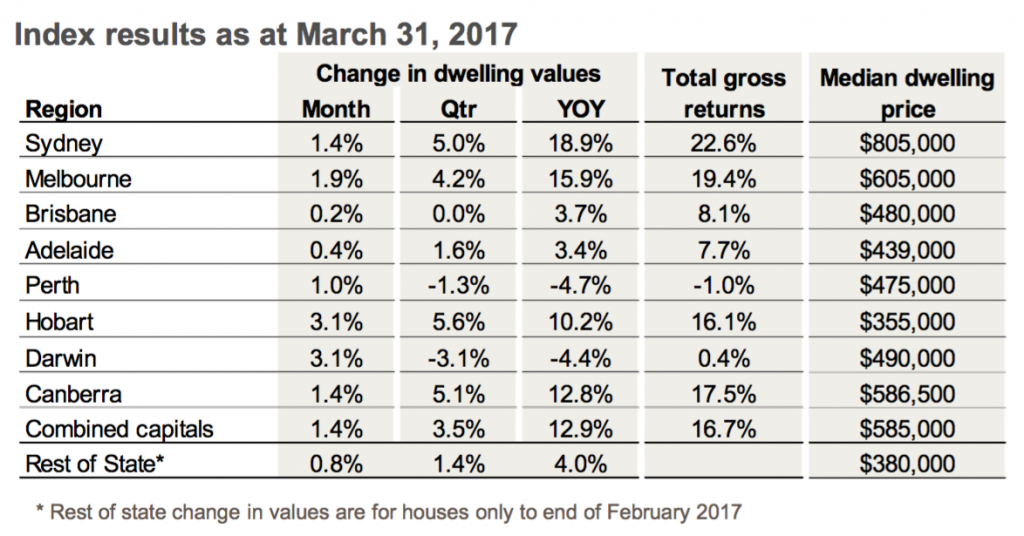 Source: CoreLogic
Source: CoreLogic
To add some context, here’s a few charts I created from ABS data showing the growth in home prices since 2003 in relation to the growth in consumer prices and rents. The first chart shows home price data for Sydney and Melbourne. For the sake of comparison to the nation as a whole, the second chart highlights Brisbane, Adelaide, and Perth home prices.
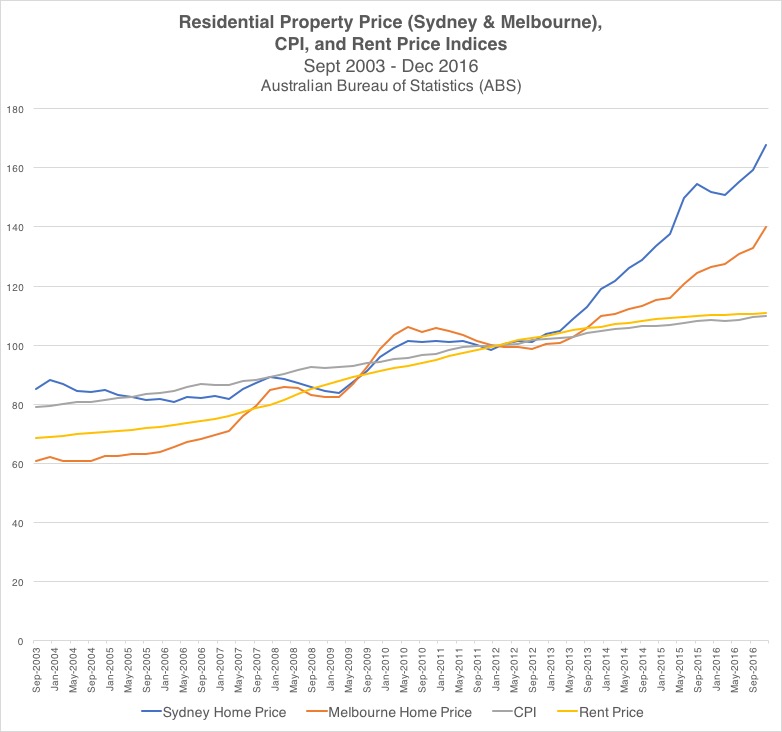
As you can see, Sydney and Melbourne home prices have grown at a much faster pace than consumer prices and rents.
The rest of the country is a mixed bag. Brisbane and Adelaide home prices have only marginally outpaced increases in consumer prices and rents, while Perth home prices are lagging behind.
What It Means For Investors
 With auction clearance rates screaming and the latest house price data confirming rapid rises in property prices, we’re hearing a lot more bubble talk again in the media.
With auction clearance rates screaming and the latest house price data confirming rapid rises in property prices, we’re hearing a lot more bubble talk again in the media.
So, is this a bubble or not? Well, I guess that depends on how you define a bubble.
According to Investopedia…
A bubble is an economic cycle characterized by rapid escalation of asset prices followed by a contraction. It is created by a surge in asset prices unwarranted by the fundamentals of the asset and driven by exuberant market behavior. When no more investors are willing to buy at the elevated price, a massive selloff occurs, causing the bubble to deflate.
By that definition, we never really know it was a bubble until after it bursts. But Investopedia also offers us a few signs that a bubble could be forming. Here are the two things to watch out for:
- growth “unwarranted by the fundamentals”, and
- “exuberant market behaviour.”
If you’ve been to any Sydney or Melbourne auctions lately, you’ll agree that there’s plenty of “exuberant market behaviour” around. Just this weekend, a Glen Iris deceased estate sold for $1.2 million over reserve, and a Canterbury period home sold for $500,000 over reserve.
But is the current level of growth “unwarranted by the fundamentals”? Before we can answer that question, we need to know what the fundamentals of supply and demand in the real estate market actually are. In other words, what brings long-term sustainable growth in house prices?
Here are the obvious drivers of growth:
- an increase in the number of jobs available in an area
- growth in wages
- population growth
Those are all factors that will contribute to the betterment of the economy, as a whole. They are “fundamental” in the sense that they are not necessarily created by government or regulatory intervention in the market. They are factors at work in a free market.
But there are other drivers impacting the growth of real estate prices that could be considered less sustainable and perhaps not “fundamental.” They include:
- artificially low interest rates
- loose lending policies
- tax incentives for investors
- restrictions on supply due to urban planning
If any of these less sustainable factors are contributing to exuberant growth of real estate prices, then we need to ask the question, “how likely is it that they go away?” And if they do go away, “what will be the impact on market exuberance, and therefore prices?”
Back to my charts from above…
I’d like to suggest that the grey and yellow lines, which represent changes in consumer prices and rents, are a good reflection of the fundamentals of our economy. Prices are rising and rents are increasing more or less in line with growth in wages.
The blue and orange lines, which represent growth in Sydney and Melbourne home prices, are clearly “characterized by rapid escalation” when compared to the “fundamentals,” which are causing only a gradual increase in consumer prices and rents.
So what’s driving the “rapid escalation of asset prices” in our two largest cities?
Here’s that first chart from above again, this time with the RBA cash rate movements overlaid:
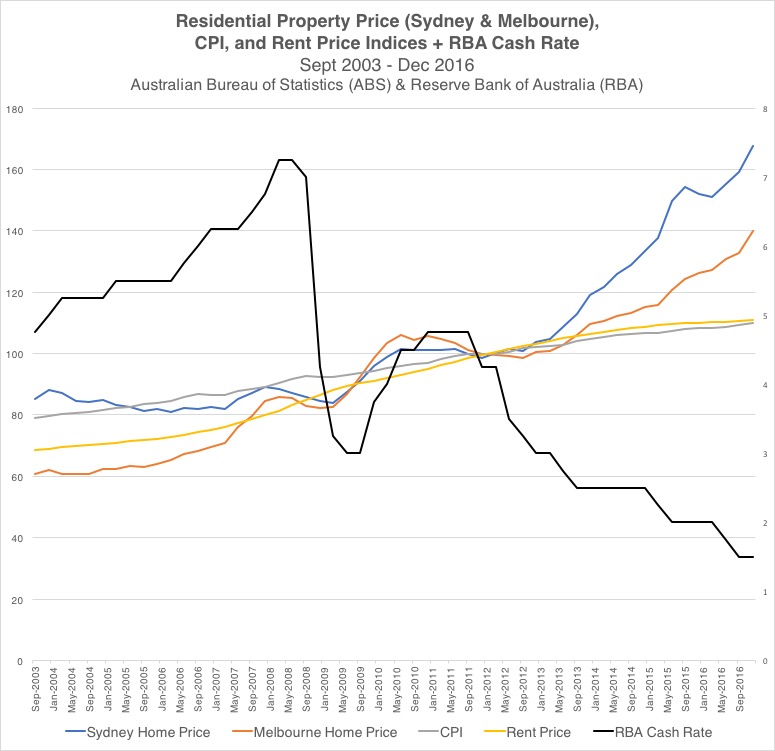
Do you recognise anything significant? If you go back to late 2011, about a year before home values started rising exponentially, all of the lines intersect at the same spot. Then as the RBA begins slashing the cash rate, home prices start rising.
Here we have growth that is clearly a result of ultra-low interest rates, driven by the RBA, our monetary policy regulator. I do not consider that a fundamental factor, and low interest rates is certainly a factor that may change.
Do you think it’s safe to say that if and when interest rates rise, home prices will begin falling? It sure seems like there’s a connection.
How high do you think the cash rate would need to go in order to get all of those lines to intersect again? Maybe 5 percent? If so, and the blue line touches the yellow line, that means Sydney house prices lose about 35 percent. Ouch!
Or could mortgage interest rates go that high even if the RBA keeps suppressing the overnight bank lending rate (cash rate)? Check out this article if you want to consider that question.
And what about the answer you came here for – are we in a bubble? Well, according to Investopedia, no one truly knows until prices contract. But it sure seems like we’re seeing “exuberant market behaviour” that’s “unwarranted by the fundamentals.”
Assuming we are in a bubble, does that mean the bubble will necessarily burst this year, or next? Will the blue and orange lines realign with the fundamentals and touch the yellow line again anytime soon? That depends on interest rates, lending policies, investor tax incentives, and other factors overseas.
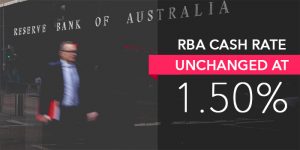 The RBA kept the cash rate on hold today, and it sure doesn’t seem like they have the scope to start raising the cash rate anytime soon. And I doubt APRA will be trying to crash the real estate market.
The RBA kept the cash rate on hold today, and it sure doesn’t seem like they have the scope to start raising the cash rate anytime soon. And I doubt APRA will be trying to crash the real estate market.
One thing we do know though is our regulators don’t want home prices to go much higher than they already are, especially in our two largest cities. APRA will, therefore, be gently applying more and more pressure until prices stop rising. You can count on that, and APRA will succeed.
If you’re still speculating on rising prices, APRA is a very powerful force you’re up against. And from my perspective, the fundamentals of inflation and growth in rents and wages are clearly not in your favour.
What do you think? If you have a moment, I’d love to hear your thoughts on any of the following questions:
Bubble or no bubble? What’s your opinion?
What do you think the standard variable mortgage rate would be if the RBA was not suppressing rates; if they allowed the free market to set its own borrowing costs?
How high do you see mortgage interest rates going in the next 3 to 5 years? How would that impact home prices?
—
The auction results listed here are based on preliminary reporting by CoreLogic, which is likely to be revised once a full reporting is made. The final results will be detailed in next week’s post.
For the historical data of weekly auction clearance rates, click here.
Comments
Got something to say? Post a comment...
You must be logged in to post a comment.

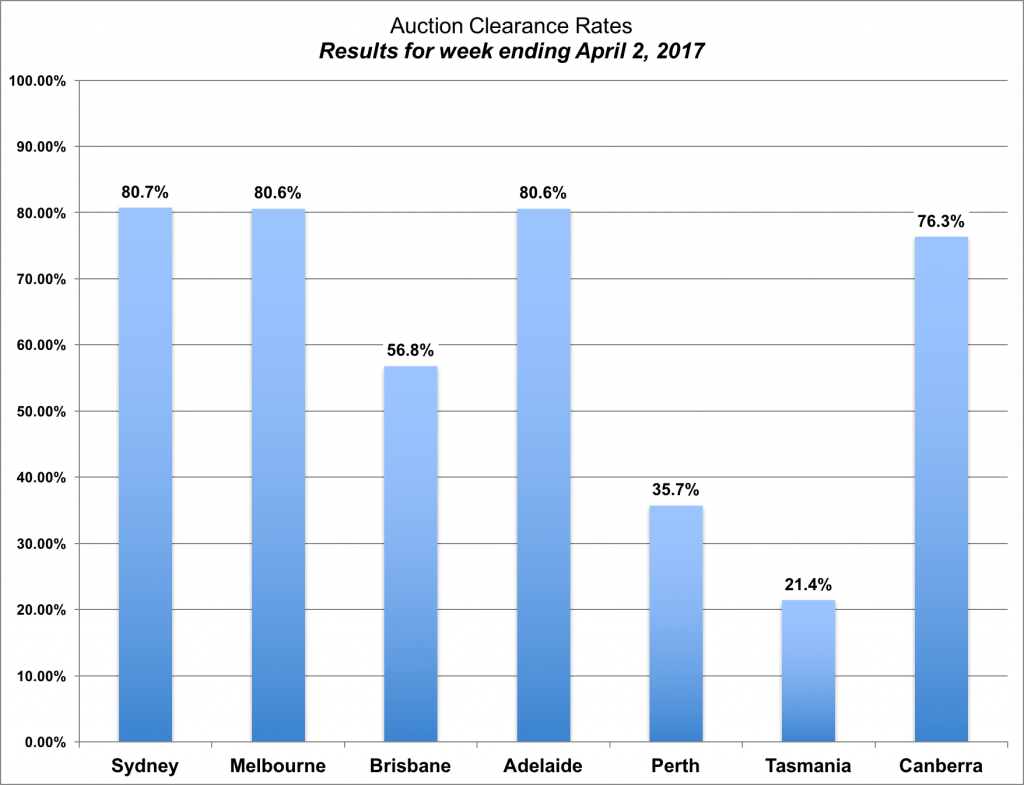
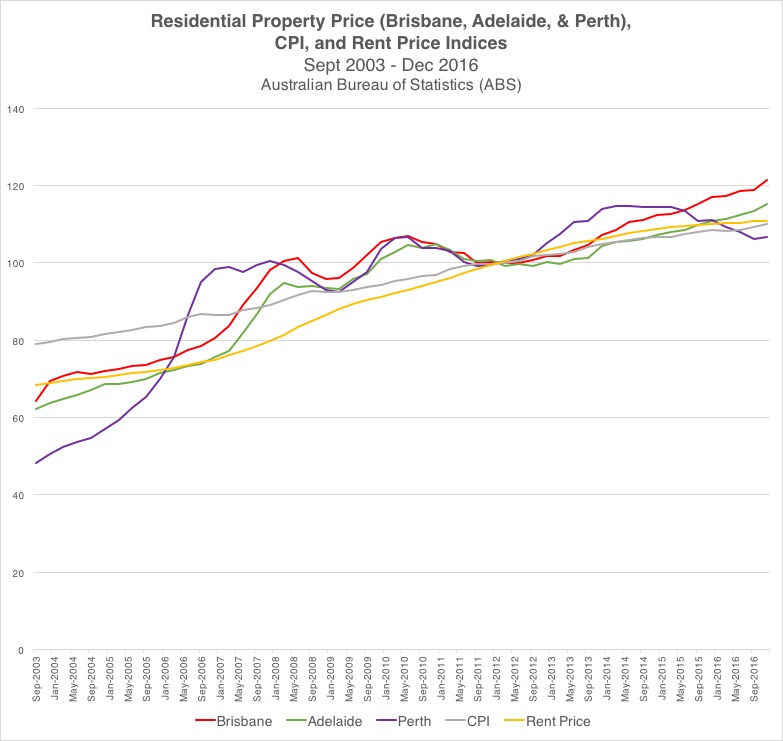




Jason, you just can’t take one factor (interest rates) out of a bunch of other important factors and predict that the market will crash the same as the USA and Ireland. In these cases there was massive oversupply of properties exacerbating the massive downturn. So if interest rates go up there may be a sell off of property but because there is a shortage of property I predict the market will recover quickly (people snapping up bargains) unlike what happened in the USA and Ireland. We see the same thing in the share market when there is a sell off (eg. people taking profits) but we soon see the share price rebound.
Hi Steve. Thanks for your comment. That’s an interesting perspective on supply, and I agree up to a point.
But from my perspective, interest rates are overwhelmingly the primary driver of the recent growth we’ve seen. I think it’s undeniable from looking at that last chart, and I suspect we would see a reversal of prices in line with rises in interest rates.
But I guess it all comes down to how much rates rise. Whether or not the property market can rebound from a significant spike in rates would depend on the credit markets and how much cash is still lying around. As long as people have deposits and borrowing power, you may be right, and that will depend upon the RBA, APRA, and overseas credit markets. But typically, when rates are rising, money becomes harder to find, and that would be bearish for both home prices and shares.
To be clear, I’m not necessarily predicting a crash. My aim is to help investors see the role interest rates are playing in the current market. I think it’s more likely that interest rates will remain low for as long as our regulators can keep them low and price growth will level off as soon as APRA has its way.
I think as long as Australian’s door is opened to immigrants, the price of housing will keep going up. There are plenty of rich immigrants afford to pay off the houses they like. By that time, bank can’t earn money they suppose to earn, and at the same time the housing price will keep rising because it’s lack of supply!
Good point Karen. As long as China can keep printing money, I agree, it will keep flowing into our property market.
Hi jason, just wanting to say thank you for continuing to keep all of us informed! I look forward to reading your updates every week and appreciate the time and effort you put in
Thanks Matt for taking the time to leave a comment. All the best.
Hi Jason, thanks for the great discussion. What can we say about Brisbane? Would it be affected same as Sydney and Melbourne in a price downtown. My impression is that price growth has been lower and patchier over the past 10 years – perhaps because of rising supply of units mainly. What do you think?
Hi Ross. Interesting question. Here’s the same data for Sydney, Melbourne and Brisbane, but on one chart:
As you can see, Brisbane has pretty much followed Sydney and Melbourne, indicating that there are nationwide drivers of growth (low interest rates, relatively easy lending standards, investor tax concessions, and the strength of the overall economy) and then more local drivers of growth (jobs, wages, lifestyle, population growth, and urban planning policies).
That said, I would expect a downturn in Brisbane if mortgage interest rates rise, lending policies or tax laws change, or if the economy in general takes a dive. An exception to that would be if APRA specified unique lending standards for Sydney and Melbourne investors, similar to Auckland’s lower LVR requirements.
If interest rates remain low and nothing else changes substantially, we may see Brisbane strengthen a little relative to Sydney and Melbourne as investors look for cheaper capital city properties.
Regarding your reference to the rising supply of units, that may have had some impact, but Melbourne also has a unit oversupply problem but continues to grow significantly. I tend to see Sydney and Melbourne strength more related to jobs, population growth, and urban planning supply shortages.
Thanks for commenting :)
Hi Jason There is so much money around at the moment its gotta go somewhere . 2 Factors which dont seem to get much air .1. So much of Sydney has been rezoned for higher density living or for residential subdivision that many millionaires have been created overnight . During the last state labour government little was done by way of supply …All these new millionaires have to move somewhere and have money to spend . + they have kids they want to help (and often do help substantially) …2. granny flats …all of a sudden larger blocks in existing areas (that weren’t rezoned for flats) became more valuable increasing prices for these properties ..more wealth creation .. .After the decade of inactivity the build up in demand in Sydney was like a pressure cooker ..it takes time to build and subdivide ..and still the population increases ..so supply and demand are the ruling forces(as always) ..The interest rate is relevant but dropping it another .25% wasn’t the wisest thing to do for the property market ..however other factors played in such as the impact on the exchange rate ..another .25% – .5% rise shouldn’t dampen the market much unless jobs disappear.. then it will be a race to the door …but if the population keeps growing so will demand …just my 2 bob’s worth.
Hi Peter. Great insight on the wealth created through rezoning. I just saw a 2br home in Box Hill listed for $7 million in hopes of attracting a developer to build a 10 story apartment building. That’s crazy money. I would just add though that such sales prices are only possible because of the assumption that buyers will be around to pay today’s prices once those units are built. That will only be possible if interest rates remain low.
Thanks for the insightful comment.
Hi Jason,
I think that the extreme increase of property prices in combination with low interest rates and usually variable interest rate mortgages are an extremely dangerous investment scenario. Many investors are at the limit of what they can afford to pay for the mortgage interest and as prices are high the majority are negatively geared. This means that, even if interest rates rise only marginally, many people might be forced to sell. This leads to a sudden peak in supply and decrease in property prices. Many people are hoping for capital gains which do not happen in such an environment. This will push more people to sell as they discover they lose money through negative gearing. In turn property prices will fall further…. Well, admittedly this is a doomsday scenario. But even if this worst case scenario doesn’t happen, it is for sure that capital gains from property are much less in the future and over the long run this market has to correct.
I am still sort of an outsider with respect to property investing as I am currently more into shares. If a crash happens I might be looking for bargains in the property market. However, the prices will have to fall substantially for me to invest: Typical rental returns e.g. in Sydney are around 2.5%. Unless these increase to around 5+% again, I am always better off with stock picking…
Maybe a bit of a different opinion but this is my honest opinion.
Cheers,
Andre
Hi Andre. Thanks for commenting. I think there are a lot of people who share your opinion, especially my American friends. Let’s not forget that it was variable rate loans that brought down the US property market in 2008. I wonder if Aussie investors sometimes underestimate the interest rate risk associated with variable loans.
It’s definitely important to get some education before investing in property and carefully consider the current market when choosing your location and strategy.